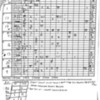coach2709 posted: I'll be honest and say that I haven't kept up with this topic as I only get to peruse occasionally now a days but what I've read the question is from stats is where is data / empirical evidence showing that coaches calling the game is more successful. Well when I read that what pops in my mind is where is the data / empirical evidence showing catcher / pitcher calling their own game and their success rate? That data is about as abundant as the data showing coaches calling games success rate. This is literally something nobody at the HS level is going to track. Plus there are SOOOO many factors to consider that it makes it impossible to track. I would guess it would take several years to compile this data. It's just not worth it. Come up with a system you like and are comfortable with that you can teach and run with it.
This spring I'm back in the saddle after being out for 9 years and I have a completely new staff with a bunch of guys that due to me coaching softball I haven't got a chance to watch play much. There's a lot of unknowns going on here. My pitching coach and I have talked extensively about philosophy and how we want to approach hitters. While he and I are on the same page there is still going to be a learning curve. My catcher is a senior and has started for 3 years. My PC is going to call the game early in the season and turn that duty over to him as the season progresses. With all the newness going on I'm not going to trust games to him until he shows he understands what we want. So first 2 or 3 games PC calls the game. Next few games we will let him call certain innings / batters but the entire time we are going to talk to him. If he doesn't get what we want then PC will call the games.
You’re correct that there are lots of factors involved, but nothing’s impossible if someone really wanted to track it. There just has to be a willingness to do it.![]() IEBSBL and ironhorse are likely typical of coaches who do, where they only look at a small number of factors and use the results to help them make their decisions. Ironhorse looks at FB vs OS by count. IEBSBL incorporates cursory pitch locations, whether the pitch was swung at, the runner and out situation, and the result of the PA. And that’s only 2 guys out of tens of thousands, so it’s not that there isn’t an abundance of data out there. The problem is, the data isn’t kept in a form that can be easily interrogated, such as an electronic database.
IEBSBL and ironhorse are likely typical of coaches who do, where they only look at a small number of factors and use the results to help them make their decisions. Ironhorse looks at FB vs OS by count. IEBSBL incorporates cursory pitch locations, whether the pitch was swung at, the runner and out situation, and the result of the PA. And that’s only 2 guys out of tens of thousands, so it’s not that there isn’t an abundance of data out there. The problem is, the data isn’t kept in a form that can be easily interrogated, such as an electronic database.
As to whether or not it would be “worth” it to have the data and a way to interrogate it, that’s the topic for another debate. My firm belief is there wouldn’t be much of a difference no matter who called the pitches, but the only way to know for sure is track what happens when the catcher calls pitches and compare it to when the bench calls pitches. If you really do as you plan, that should be a pretty simple thing to do. Just compare opponent performance however you want to measure it, and look at it for the 3 different scenarios, i.e. bench calling, catcher calling, a combination of the two.
You said; With all the newness going on I'm not going to trust games to him until he shows he understands what we want. What is it you want? It seems to me that that’s the real question. How will you determine If he doesn't get what we want?
BTW, I wish you nothing but the best of luck in the upcoming season! Will you be using MaxPreps or something like it?

